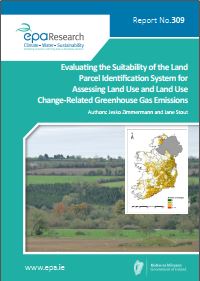Research 309: Evaluating the Suitability of the Land Parcel Identification System for Assessing Land Use and Land Use Change-Related Greenhouse Gas Emissions
Authors: Jesko Zimmermann and Jane Stout
Summary: Land use and land use change have a significant impact on national greenhouse gas (GHG) emissions and are therefore an integral part of national GHG reporting, as laid out by the United Nations Framework Convention on Climate Change. In Ireland, land use and land use change reporting is currently based on total national agricultural area data provided by the Central Statistics Office.

Land use and land use change are important drivers in national greenhouse gas dynamics and therefore are integral to Ireland’s greenhouse gas reporting efforts. Spatially explicit data on land use and land use change, however, are sparse, limiting the understanding of the extent of land use change and the capacity to understand the context of land use with regard to other important environmental factors, such as climate and soil.
The Land Parcel Identification System (LPIS), a high spatial and temporal resolution database developed as part of the European Union Common Agricultural Policy to assist farmers and authorities with agricultural subsidies, potentially provides a wealth of data on land use and land use change in Irish agriculture. As the LPIS was not designed for the needs of national greenhouse gas reporting, its potential strengths and limitations needed to be assessed.
The study demonstrated that, in general, reporting on arable crops showed both a high spatial and a high thematic resolution. With regard to grasslands, however, thematic accuracy was limited as different grassland categories were exchangeable (e.g. “grass” and “permanent grassland”). In addition, although more detailed categories existed (e.g. “rough grazing”), these were not always reported. Similarly, forestry was reported in the LPIS but reporting was not comprehensive.
Identifying Pressures
An in-depth analysis of the LPIS data showed regular changes between croplands and grasslands. This suggests that croplands are much more dynamic than previously assumed. This is highly relevant to greenhouse gas reporting as temporary grasslands should, under regulations, be considered as croplands.
Informing Policy
Research findings have been published in peer-reviewed journals and at conferences. The research was carried out in close conjunction with the Environmental Protection Agency (EPA) greenhouse gas reporting staff and results from the project have directly fed into land use and land use change methodology.
Developing Solutions
A set of ArcGIS tools was developed to pre-process the raw LPIS data received by the EPA. Furthermore, tools to account for land use change over time were created. The tools are currently being used in land use and land use change reporting efforts.
https://www.epa.ie/media/archive/research/research-thumbnails/Research_309_thumbnail.jpg